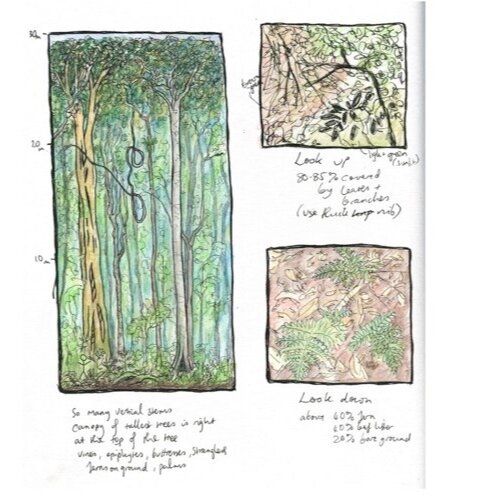2nd June 2022
Pictures
Pictures are a wonderful way to explore a natural subject in your nature journal. You can use sketches, paintings, diagrams, maps, cartoons or even stick figures. Taking the time to draw a subject will help you understand it more fully.
Workshops
There will be two live demonstrations and a live workshop today to explore using pictures in our nature journals. Please click the links below to learn more about each workshop.
2nd June 2021, 9 AM - 11 AM Pacific (11 AM - 1 PM CDT)
Liz Clayton Fuller -
Bird Art Painting Demonstration
2nd June 2021, 4:30 PM - 6:00 PM Pacific (6:30 PM - 8:00 PM CDT)
Timothy Joe -
Art demonstration
We also have a pre-recorded workshop with botanical artist Marina Cerra (Italian with English subtitles):
Botanical art workshop with Marina Cerra
Find the English version of Marina’s resources here: Botanical Notes and Botanical Notes Checklist.
Find the Italian copies here: Appunti di botanica e Appunti di botanica checklist.
Nature journaling prompts and ideas
Sketches - A sketch is an image that has been quickly captured with a few rough or unfinished lines. Sketches are perfect for a nature journal because you don’t always have time to capture every detail when you’re out in nature. Try sketching birds or animals that are moving. It can be tricky but very enjoyable! Sketches are not supposed to be perfect, so let yourself relax and enjoy the process.
Drawings - A nature journal can also include more finished drawings. You could start with a sketch in the field and then work it into a more finished drawing later, when you are at home. You might like to use sketching and drawing in combination, to create different visual elements on one page, some rough and quick, and others more complete with detail and shading.
Diagrams - A diagram is simplified image of something that shows its structure, details or function. Diagrams are perfect in a nature journal because they help us explore a nature subject more deeply. Start with a sketch or drawing and then add labels to describe the features. For example, you might start with a sketch of a bird. Then you can add lines coming from various points on the animal. Add labels to describe the bird’s appearance or special features. Diagrams are used in science all the time. By creating diagrams of what you see, you are adding a little science to your nature journal too!
Comics/Cartoons - Comics can be a wonderful way of capturing a sequence of events, or a series of movements, in your nature journal. Try using comics to represent an event that you witnessed while in nature. Sit still in one place for a while and you will notice that animals begin to feel comfortable with your presence. You are then able to watch them go about their daily activities. You might, for example, see a pair of birds coming and going from a nest, finding food for newly hatched chicks. Try to capture animal activities as a series of quick cartoons in your nature journal. Draw several small boxes and draw one part of the sequence in each box. Keep it small, so that it’s not intimidating. Have fun with it!
Maps - Maps are a fun way to understand your landscape. Create a map in your nature journal using simplified shapes and a key to explaining what each symbol represents.
Paintings - Watercolour and gouache are perfect media for nature journaling because they’re portable and easy to clean up. You can add paintings to your nature journal pages either in the field or at home, from photographs. Try adding a quick, painted landscape to your nature journal page, to represent the natural scene that you were exploring.
Learn more
Australian ecologist and nature journal teacher, Paula Peeters, has developed a wonderful way to visually describe an ecosystem, capturing the signifiant aspects, such as height, canopy cover, ground cover and important vegetation and other lifeforms. You can read a description of how to do this on Paula’s blog.
Among the many resources on Roseann Hanson's Exploring Overland Field Arts page is a fascinating post about a special form of map - the strip map. These unusual maps are a fun way to capture nature outings using simple diagrams, symbols, and sketches. You can hear more about Roseann's nature journals and journeys on the Journaling with Nature podcast.
Betty Edward's book, Drawing on the Right Side of the Brain, is a timeless resource for anyone who wants to improve their drawing skills. It's often available where you find used books or at your public library. While neuroscience has progressed since the book was first written, the exercises in it have become classic ones used by many nature journalers because they are fun, and they work. One of these exercises is the "blind contour", which is described here.
Some of the oldest known paintings in the world are found in caves in Europe. Prehistoric artists captured the essence of the animals in their environment using the natural materials they had available. These simple but powerful images may inspire you to capture your subjects using a minimum amount of lines, brush-strokes, or colours.











